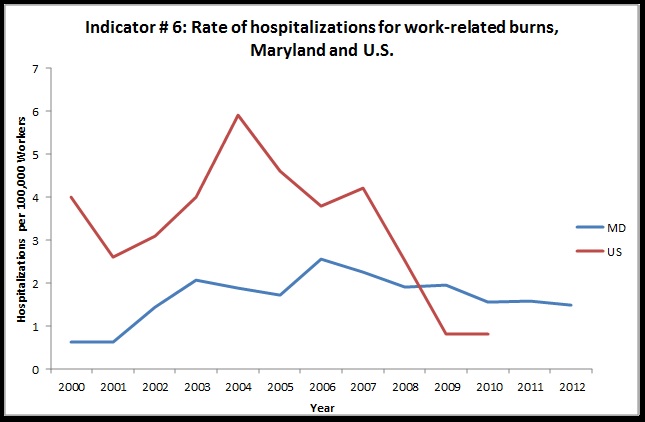Indicator #6: Hospitalizations for Work-Related Burns

Burns encompass injuries to tissues caused by contact with dry heat (fire), moist heat (steam), chemicals, electricity, friction, or radiation. Burns are among the most expensive work-related injuries to treat and can result in significant disability. Thermal and chemical burns are the most frequent types of work-related burn injury. A substantial proportion of burns occur in the service industry, especially in food service, often disproportionately affecting working adolescents.
Graph

Table
Indicator #6: Hospitalizations for Work-Related Burns, Maryland
| Year | Number | Rate* |
|---|
| *Rate per 100,000 workers |
| 2000 | 17 | 0.63 |
| 2001 | 17 | 0.62 |
| 2002 | 40 | 1.44 |
| 2003 | 57 | 2.06 |
| 2004 | 52 | 1.88 |
| 2005 | 48 | 1.71 |
| 2006 | 74 | 2.56 |
| 2007 | 65 | 2.26 |
| 2008 | 55 | 1.91 |
| 2009 | 55 | 2.0 |
| 2010 | 44 | 1.6 |
2011
2012 | 45
43 | 1.6
1.5 |
| 2012 | 43 | 1.5 |
| 2013 | 34 | 1.2 |
| 2014 | 30 | 1.0 |
| 2015 | 15 | 0.5 |
| 2016 | 36 | 1.1 |
| 2017 | 25 | 0.8 |
| 2018 | 18 | 0.6 |
| 2019 | 20 | 0.6 |
| 2020 | 12 | 0.4 |
More about this Indicator
Why is this indicator important?
Work-related burns are some of the most devastating injuries affecting workers. Although hospitalized burns are unusual events, they are painful, disabling, and expensive to treat. Many result in significant disfigurement. In addition, burns are the most common cause of work-related hospitalization for young workers.
Data Source for this indicator
Maryland Hospital Discharge Data (number of work-related hospitalizations); Bureau of Labor Statistics Current Population Survey (total number of employed persons).
U.S. data and information about this indicator obtained from http://www.cste.org/general/custom.asp?page=OHIndicators
Limitation of Indicator
Work-related burn injuries are experienced by employed individuals less than 16 years old, but corresponding denominator data is not readily available. Practice patterns and payment mechanisms may affect decisions by health care providers to hospitalize patients. Residents of one state may be hospitalized in another state and not be reflected in his/her state’s hospitalization data. Until hospital discharge data is available in all states, aggregation of state data to produce nationwide estimates will be incomplete. Data on race/ethnicity is not collected in some states and is incomplete and/or of questionable validity in others. Hospital Discharge records are only available for non-federal, acute care hospitals.

